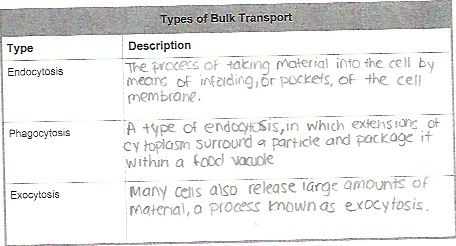C 1. Which of the following must be true for diffusion to occur?
A. Molecules or particles must have different sizes
B. Special protein channels must always be available
C. There must be areas of different concentrations
D. Energy must be available
B 2. Which term refers to the condition that exists when no net change in concentration results from diffusion.
A. concentration
B. equilibrium
C. osmosis
D. randomness
A. in the air breathed in
B. in the air breathed out
C. outside of the lung cells
D. inside of the lung cellsC 4. Which of the following statements tells how facilitated diffusion differs from simple diffusion.
A. Particles move through cell membranes without the use of energy by cells.
B. Particles tend to move from high concentration to lower concentration.
C. Particles move within channel proteins that pass through cell membranes.
D. Particles tend to move more slowly than they would be expected to move.For Questions 5-7, match the situation with the result. Write the letter of the correct answer on the line at the left.
Situation Result
C 5. Cells are in an isotonic solution. A. The cells lose water
A 6. Cells are in a hypertonic solution. B. The cells gain water
B 7. Cells are in a hypotonic solution. C. The cells stay the same.
8. THINK VISUALLY In the table below, draw how each type of cell will look after being placed in a hypertonic solution.
Active Transport
9. What is the function of active transport in moving small molecules and ions across cell membranes? Give an example.
Active Transport is the movement of materials against a concentration difference, and it does require energy. For example, cells can concentrate substance such as: calcium, potassium, and sodium ions across cell membranes. This is the result of diffusion, and wouldn't occur without it.
10. How does ATP enable transport proteins to move ions across a cell membrane?
ATP enables transport because energy from ATP causes a transport protein to change shape.
11. What are the proteins used in active transport called?
Protein pumps
12. Complete the table to summarize the types of bulk transport.
Apple the BIG Idea
13. Answer only: (below)Athletes should drink solutions that are isotonic because isotonic restores both water and nutrients, which is lost due to perspiring. Water alone or hypotonic fluid doesn't restore the nutrients, and drinking too much hypotonic fluids can cause water to enter the bloodstream. That's why athletes prefer Gatorade so they can get electrolytes vs hypotonic fluids.


No comments:
Post a Comment